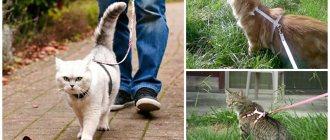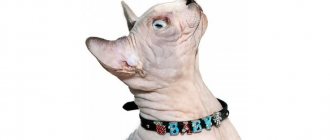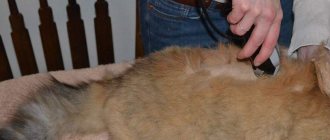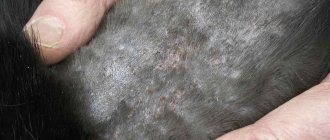DIY cat harness
Before going outside with a cat, the owner needs to study the issue of a deterrent - a leash. This will help you not to worry that your pet will run away, climb a tree, or get lost during a walk. But how do you know what kind of leash you need? You will learn about all the variety of types and materials, as well as the question of how to make a leash (harness) for a cat yourself in this article.
What is a harness and why is it needed?
There are quite a few types of leashes; in addition, instead of them, another device called a harness can be used to walk a cat. Its difference from a leash is that its design allows you to avoid the use of a collar. This has a better effect on the physical health of the pet.
A cat leash makes walking with your pet easier
Harnesses come in different shapes:
- H-shaped;
- Y-shaped;
- V-shaped;
- eight;
- vest.
The essence of the device is that the leash is attached to straps that wrap around the cat’s body, or to a special overalls. This distributes the stress of pulling on the leash differently than when using a regular collar, and there is less risk for your pet to suffer physical injury.
Why are cat leashes necessary?
How to put a harness on a cat: options with different types
Not all cat owners know that their pets can be walked like dogs. Cats are usually kept as exclusively domestic animals, especially if the family lives in a metropolis, where there is no opportunity to let the cat go for an independent walk, as in the village.
However, these animals also love walks. They are not a necessary part of caring for a pet, but they can significantly diversify and brighten up a cat’s life, as well as add more opportunities for physical activity.
A cat on a leash can run and play safely during a walk.
To prevent the cat from running away while walking and to stay close to the owner, a cat leash is used. Walking a cat without a leash is also possible, but if it gets scared or something attracts its attention, the owner will have no control over the pet, and this can either lead to the animal getting lost or to more serious consequences if events occur, for example, near the roadway.
Important! In addition to walks, leashes and harnesses are also useful during trips to the veterinarian and various trips if owners do not have a special carrier.
Advantages of leashes
Main advantages:
- You will be able to go for walks in nature without fear that the animal may run away. Your cat will be happy from walks in the fresh air, which will also have a positive effect on her health and well-being.
- You will control your animal, and it will not be able to climb into hard-to-reach places, for example, climb a tree.
- You will regulate the distance between you and your pet with such an accessory.
- Your pet will be constantly visible during a walk, and you will be able to make sure that he does not eat anything on the street, does not jump into a trash can or other equally unpleasant places.
- The duration of the walk is determined by you, and at the end of it you do not need to look for and catch the cat all over the street or lawn.
- If you plan to participate in exhibitions with your pet, then you cannot do without a leash.
- A leash will make your trips to the vet much easier.
Cons of cat harnesses
In addition to the advantages, there are some disadvantages of this accessory:
- The cat may simply panic at the sight of the harness, break free, and become agitated and nervous. In his impulses to free himself, he can harm himself.
- The harness and leash must be securely fastened and secured, otherwise the animal will be able to break free and run away.
- A product made from cheap fabric may tear.
Interesting: DIY cat harness and leash
Pricing policy for harnesses for cats
The price range for a harness with a leash ranges from 80 to 600 Russian rubles. A collar without additional design starts from 160. Decorated collars will cost 270 rubles. Leather collars are much more expensive, about 400 rubles, and a leather leash - 300. The minimum cost of a roulette-type leash is 360 Russian rubles.
produces harnesses based on padding polyester or canvas material . You can purchase complete products from. The Anima Trade brand also specializes in the production of harnesses and leashes for cats.
When should you not use a harness?
Dog chain: kennel jerk collars
Although it is a convenient device for both the pet and its owner, using a collar with a leash for cats is not always possible. It is not recommended to use it in the following situations:
- For an older cat who is not harness-trained, trying to walk her can be very stressful, which can negatively impact her health. If the animal has never gone for walks in its life, it is not recommended to start them in old age.
- For a small kitten, you should very carefully select a suitable harness, since its body is actively growing and developing.
- Difficulties in learning to wear a harness can occur in overly fearful or aggressive animals, since due to stress they can accidentally harm themselves.
- If the cat is pregnant, has recently undergone surgery, or has any physiological defects, wearing a harness may be contraindicated, or you will have to carefully choose the model.
First walk
First of all, it is worth remembering that there are several cases in which you should not go for walks:
• With kittens under 5 months (until this time the animal does not have strong immunity) and older, if vaccinations have not been done; • With old cats that have never been outside (this can negatively affect their health); • During the rehabilitation period after illness or surgery; • If the cat is very cowardly or too aggressive.
If all this does not apply to your cat, then for the first walk it is best to choose a quiet, secluded place where there will be no strangers, cats or dogs. This could be a park or a quiet courtyard. If such a place is far from home, it is better to carry the cat there in a carrier or in your arms. In the chosen place, carefully lower the animal to the ground. At first, the cat may sit still and fearfully look at the new space. There is no need to push her, she will decide for herself when she is ready to move on. Care should be taken to ensure that no one or nothing frightens the animal, otherwise this may discourage the animal from going for walks for a long time. Also, you should not try to force the cat to go where you want. At first it’s better to just follow her. And in the future, it’s worth coming to terms with the idea that it’s not you who walk the cat, but the cat who walks you. Very little time will pass, and such walks will bring a lot of pleasure to both you and your pet.
How to put a harness on a cat
Types of cat harnesses
Cat harness: main types and DIY options
Choosing the shape of a harness mainly comes down to understanding which model is most comfortable for your pet. Descriptions of some of the main types are given below.
Important! You may have to try several different models before you can find the right one.
H-harness
A leash for cats can be H-shaped. This is one of the most popular types of harnesses: two straps are connected by two straps on the sides, one of the straps goes around the cat's neck, the second goes around the chest behind the front paws.
Figure-of-eight harness
This harness consists of two straps fastened in a figure eight shape. Assembling and putting it on your cat can be difficult, and this model is also not suitable for overly active animals, as they can get tangled in the straps. However, for calm cats, the “eight” will be a good option.
Harness vest
The pet can also be dressed in cat overalls. This is the safest model of harnesses, giving scope for many interesting decorative solutions. The vest usually has clasps on the animal's back and can be made from a variety of materials and decorated in a variety of ways.
A vest for a cat is the safest model
How to choose the right size and type of harness
If the harness is not made independently, but purchased in a store, it is very important to choose the right not only the type of design, but also its size. Belts that are too narrow can damage the animal's fur and skin, while belts that are too wide can restrict movement. The material of manufacture is also important: it must be soft and durable for the greatest comfort of the animal.
To understand that the selected size is suitable for the cat, you should put a harness on it and check whether you can stick two fingers between it and the animal’s back. If not, the size of the product is too small and will embarrass your pet during a long walk.
Important! The best option would be a harness, the size of which can be adjusted.
How to choose the right harness and cat leash
Choosing the right harness will allow you to quickly accustom your pet to it. If the cat doesn’t like the device, he will become aggressive, and there is even a risk of escape. Therefore, pay attention to the quality of the harness and the material from which it is made.
Material selection
It is safest to choose harnesses made from nylon and cotton fabrics with a felt lining. Firstly, they will not rub your pet’s neck, and secondly, they are very easy to care for. It is not recommended to buy leather harnesses, as this material is too rough for cats.
The cost of cat collars starts from 160 rubles. But it is better not to purchase a cheap product, since it is usually made in China and is of low quality. If you have a large, muscular pet, there is a high chance that he will simply tear the accessory.
If you want to purchase a branded harness, it will cost you 1000 rubles or more. Very often they are made from natural suede. The price corresponds to the quality, and the device will not fail for a long time.
Harness adjustment
To choose the right accessory, you need to know your pet's chest circumference and neck size. Pay attention to the following nuance. Two fingers should fit between the lower collar and the pet's belly. Then the harness can be considered securely fastened.
The harness straps should not be too narrow. The best option is a width of one to one and a half centimeters. More expensive accessories have adjustable straps. With their help, you can really adjust the ammunition without any problems.
When buying a harness, take a closer look at the leash, which can be of two types:
- regular (length up to two meters);
- roulette.
The latter allows cats to better explore the space around them.
It is important that the fastening materials are of high quality, otherwise they may break and the cat will be free, which poses a danger to him.
How to make a harness with your own hands
A cat collar for walking can be made by hand. It can be crocheted, knitted or embroidered from fabric - the method depends on the preferences and skills of the manufacturer.
Before starting work, it is necessary to take measurements. A measuring tape is suitable for this. The following measurements should be taken:
- Cat's neck circumference. You will need to leave an additional 1-2 cm for allowances.
- Chest circumference. It is measured behind the animal's front paws at the level of the shoulder blades. Here you will also need to add a couple of centimeters so that the finished product does not fit too tightly to the body.
- Distance from the collar to the chest strap. It is measured along the line of the back.
Taking measurements for a harness is a simple procedure
It is imperative to choose a durable material for the product, and also make sure that the parts are firmly connected to each other. If the product is not created in the form of a vest, but in the form of interconnected straps, they can be fastened using special fasteners or rings.
Advice! The ring for attaching a rope or leash should be located on the back side.
The finished product can be decorated with decorative details, but it is important to ensure that the harness does not turn out to be too heavy. If possible, avoid using parts that are too small and ensure that they are securely fastened, otherwise the animal may try to chew them off.
How to put on different types of harnesses
How exactly to put a harness on a cat depends on its shape and the parts that are included in the kit, be it individual straps or full-fledged clothing items, such as a vest.
First of all, a smaller strap or collar is placed around the neck, then the front paws are inserted through the second strap. If your cat is wearing a harness, it is important to carefully fasten the straps so as not to pull them too tight.
Important! When adjusting the tightness of the tightened belts, remember that two fingers should be placed between the animal’s back and the harness.
The leash itself is attached immediately before going outside; the mount for it is always located on the back in the area of the shoulder blades.
How to train a cat to wear a leash
The sooner work begins on accustoming your pet to a cat collar for walking, the easier the process will be. The most appropriate age to start leash training and take a kitten outside is between three months and one year. During this period, the animal’s immunity has already been formed, so there is less risk of catching some disease on the street. However, if you plan to walk your cat frequently, it is recommended to take care of the appropriate vaccinations.
Teaching a kitten to a leash
For older cats, getting used to a new accessory will be more difficult. Accustoming will have to be done step by step and this process may not be quick.
- The first step is to introduce the leash to the cat. It should be left in places where the animal frequents, for example, near a favorite sleeping spot. This way the cat will get used to the presence of a new unfamiliar object. This may take time, up to several days.
- The next step is to try putting the harness on the cat. If the animal behaves aggressively or is too frightened, it is recommended to put the harness aside and try to put it on the cat again after a while.
- When the pet gets used to the belts or vest, you can attach a leash and lead the cat around the apartment.
It is recommended to go outside for the first time in a quiet place where there will not be a large number of people and other animals, as well as cars. The cat will need time to get used to the new environment, so if she does not want to go for a walk and remains sitting still, you should not force her to move.
When the animal gets used to the leash, the process of walking can bring a lot of positive emotions to both the pet and its owner.
How to properly put a harness on a cat.
Putting a harness on a cat for the first time can be quite difficult, but with some experience and skill it will only take a few seconds.
How to put a harness on a cat
So, you need to complete the following points:
1. Check if the harness is adjusted to the correct size. At first, you can unfasten the leash so that it doesn’t get tangled or interfere. 2. Pick up the cat and calm it down by petting and talking to it. 3. Place a closed ring around the cat’s neck, turning it so that the carabiner is on the back. Then we insert the front paws one by one into the second ring. If the harness has a clasp, then we insert one paw into the triangle between the closed ring, the jumper and the clasp, and place the strap with the clasp under the belly and fasten it on the back, so that the second paw is in a similar triangle. 4. Check that all carabiners are fastened and that there are no bends or creases on the straps. 5. Make sure that the cat’s harness does not press or pinch. Adjust the straps if necessary. 6. Attach the leash to the carabiner.
Now the cat is ready for a walk. However, it is very rare that animals immediately calmly accept a harness; most often they need to be prepared for this device.
Types of harnesses for cats
Types of harnesses for cats- Types of harnesses for cats











